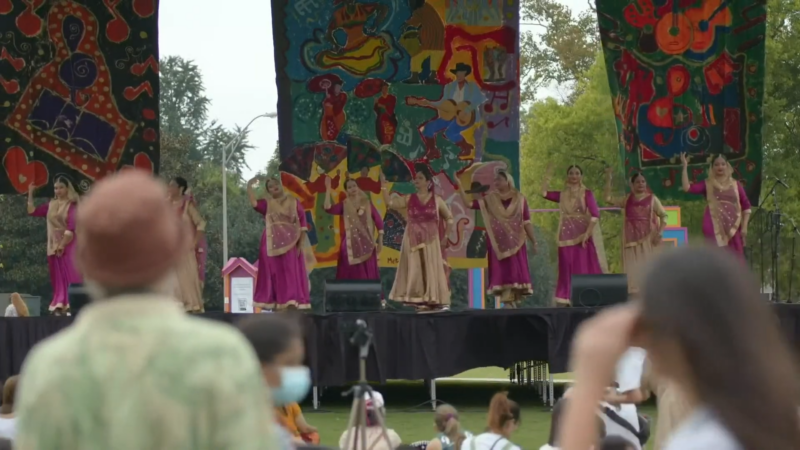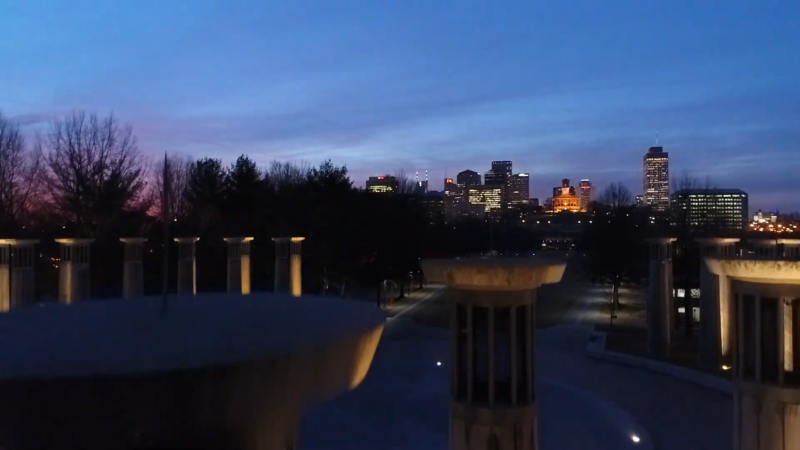Nashville, Tennessee, known for its vibrant music scene, also boasts a diverse and dynamic population. As of 2025, the city’s population stands at 687,150 according to World Population Review.
But the metro area stands at approximately 1,333,000, showing a 1.37% increase from the previous year.
By 2030, the metro area’s population is projected to reach 1,422,000, highlighting the city’s ongoing appeal and robust development.
Nashville has been named one of the fastest-growing cities in the country for 2025. This designation is supported by data from sources like the U.S. Census Bureau, which show consistent population increases across the state.
As such, the Nashville-Davidson-Murfreesboro-Franklin metro area is set to be among the fastest-growing urban areas by 2060.
Looking ahead, the United Nations projects a significant rise in Nashville’s metro population, which is expected to hit 1,483,000 by 2035.
Table of Contents
ToggleTLDR
Demographics Overview
Age Distribution
The age distribution in Nashville is relatively balanced.
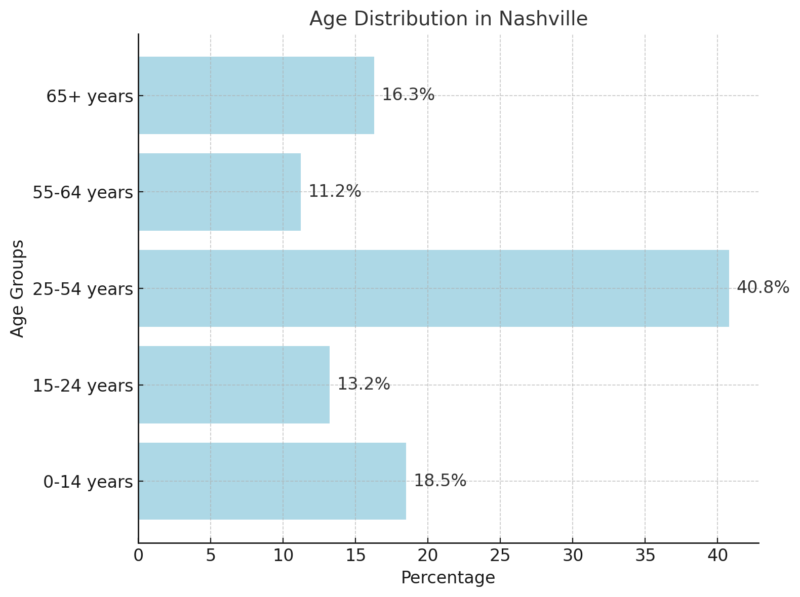
Gender Breakdown
Nashville’s population is almost evenly split between genders:
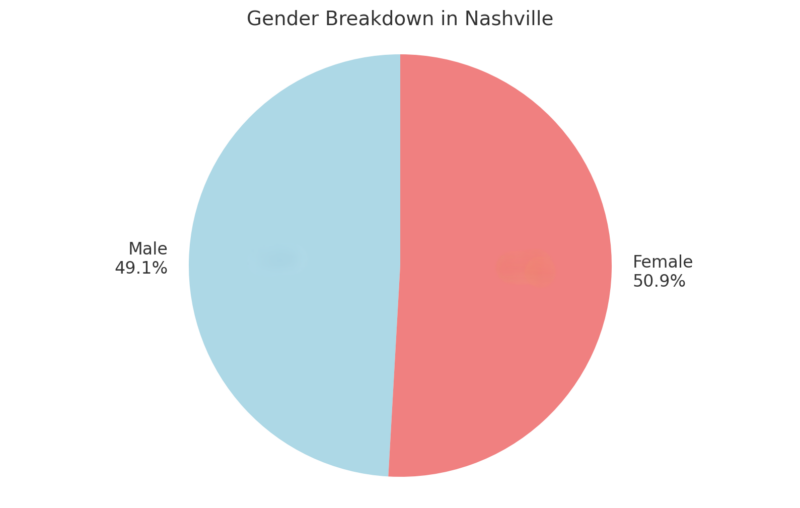
Race and Ethnicity
Race/Ethnicity
Population
Percentage
White
404,538
59.13%
Black or African American
183,398
26.81%
Two or more races
43,790
6.40%
Other race
26,238
3.84%
Asian
24,823
3.63%
Native American
958
0.14%
Native Hawaiian or Pacific Islander
358
0.05%
Income Levels
The average household income in Nashville is approximately $112,434, reflective of a developing urban economy according to Point2Homes.
Metric
Value
Y-o-Y Change
Average Household Income
$112,434
10.2%
Median Household Income
$73,138
9.2%
People below the Poverty Level
65,599
2.8%
People above the Poverty Level
379,511
0.4%
Education Levels
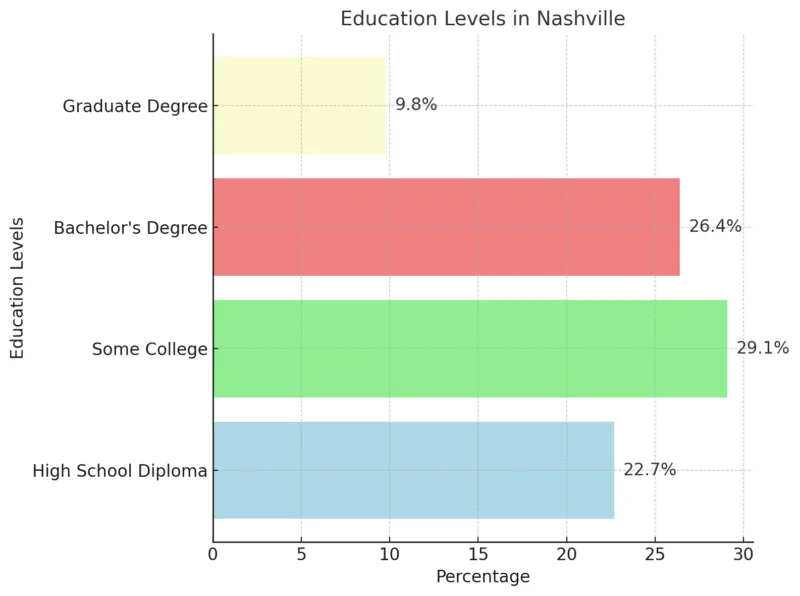
Household Types
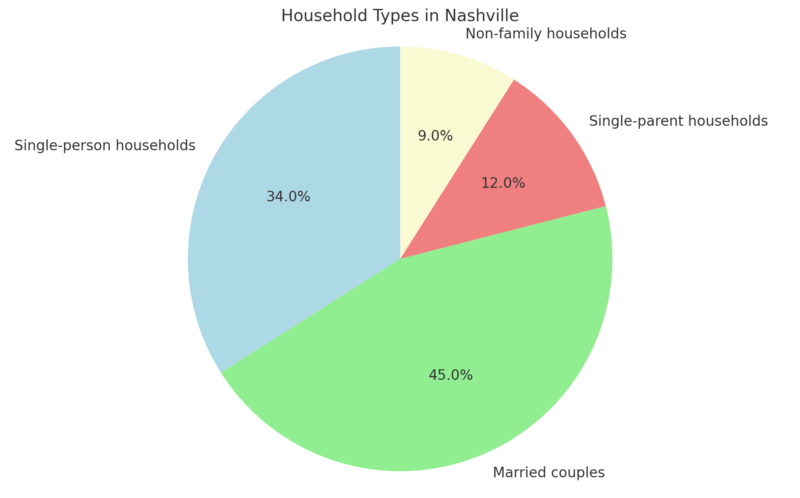
The city’s demographic trends reflect a growing suburban interest, with a significant number of new residents opting for suburban living around Nashville metro area projections.
Population Trends

2000-2010 Decadal Review
During the 2000s, Nashville saw substantial population growth, driven by economic development and an influx of new residents.
The metro area population increased from 1,231,311 in 2000 to 1,589,934 by 2010.
This period marked a shift in Nashville’s demographic profile, with a notable increase in younger professionals moving to the city for job opportunities in the burgeoning tech and healthcare industries.
Additionally, the construction boom during this time contributed to a higher rate of housing availability, further attracting new residents.
Nashville’s growth mirrors trends seen in other rapidly expanding cities like Charlotte, which has also experienced significant population increases in recent years.
As Nashville’s population continues to rise, similar to Charlotte’s expansion, the city faces challenges in infrastructure, housing, and workforce development.
2020-2024 Recent Changes
According to Macrotrends, the current population is approximately 1,333,000 as of 2024, reflecting a 1.37% increase from 2023. The influx of residents continues, with many choosing suburban areas for their residential needs.
This shift suggests a growing preference for living spaces that blend urban convenience with suburban tranquility. The COVID-19 pandemic also influenced population dynamics, as remote work became more prevalent, prompting additional migration into less densely populated areas within the metro.
Nashville’s population trajectory demonstrates consistent growth, shaped by economic opportunities, infrastructural developments, and changing residential preferences. This demographic evolution underscores the city’s adaptation to both local and global trends, projecting a continued rise in population in the foreseeable future.
2025 Population Data
Estimates and Census Figures
Nashville’s population in 2025 is estimated to be approximately 687,150 without greater area. Despite being named one of the fastest-growing cities, the city’s growth rate recently slowed, with a slight annual decline of -0.09%.
Recent data indicates a shift toward suburban living within the greater Nashville area, boosting surrounding regions. For instance, nearby Rutherford County remains the fastest-growing area, highlighting a contrasting trend between central and suburban growth.
Economic Drivers

Known for its thriving music and entertainment industry, the city also boasts significant healthcare and automotive sectors.
Major companies, such as Nissan North America and HCA Holdings, provide high employment rates and economic stability.
In a year marked by significant national economic shifts, the Nashville Metropolitan Statistical Area (MSA) experienced one of its strongest years in recent history.
From 2021 to 2022, the region saw average household income increase by over 10%, while unemployment remained at a record low of 2.7%.
Middle Tennessee also remained largely insulated from the effects of national inflation. Looking back, it’s clear that the region has demonstrated remarkable resilience in the face of global challenges, though potential economic risks could emerge in 2024.
This overview highlights key indicators such as job growth, industry performance, and investment trends, providing a comprehensive look at Nashville’s economic health according to nashvillechamber.com.
One major trend-setting Nashville apart from other cities is its vibrant workforce.
With over 120,000 students enrolled in more than 20 colleges and universities, the area continues to attract both companies and skilled talent. In 2023, Middle Tennessee saw considerable job growth, particularly in technology and healthcare, resulting in 24,000 new jobs.
Despite this progress, workforce development remains a challenge. The region still needs community-wide investment to address the more than 50,000 job openings currently available in the Nashville MSA.
Data Series
Mar 2024
Apr 2024
May 2024
June 2024
July 2024
Aug 2024 (p)
Civilian Labor Force (1,000s)
1,165.8
1,160.2
1,156.5
1,166.1
1,168.4
1,159.9
Employment (1,000s)
1,137.8
1,134.4
1,129.8
1,131.6
1,134.4
1,126.4
Unemployment (1,000s)
28.0
25.8
26.8
34.5
34.0
33.5
Unemployment Rate (%)
2.4
2.2
2.3
3.0
2.9
2.9
- Civilian Labor Force: The labor force fluctuated slightly over the months, peaking in July 2024 at 1,168.4 thousand before dropping to 1,159.9 thousand in August 2024 as per BLS report.
- Employment: Employment saw a gradual decline from 1,137.8 thousand in March 2024 to 1,126.4 thousand in August 2024, showing a slight drop in employed individuals.
- Unemployment: Unemployment figures increased significantly from March (28.0 thousand) to June (34.5 thousand), but then slightly improved, reaching 33.5 thousand in August 2024.
- Unemployment Rate: The unemployment rate rose from 2.2% in April to 3.0% in June, before settling at 2.9% in July and August 2024, indicating a rise in unemployment despite fluctuations in the labor force.
Urban Development and Housing
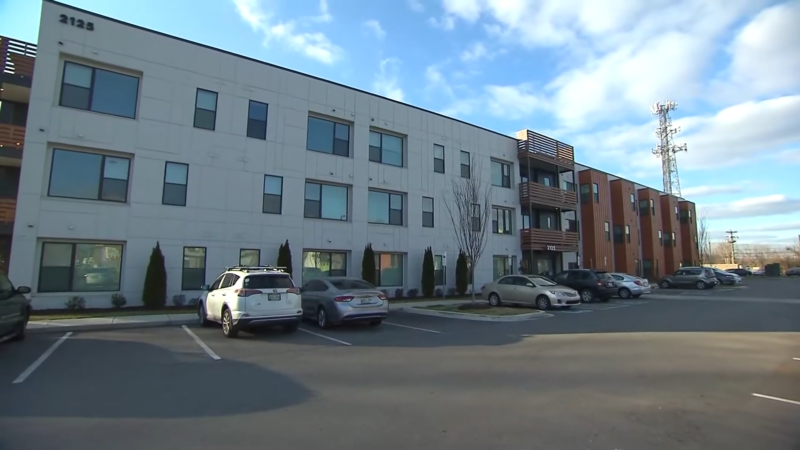
According to Zillow Nashville housing market in 2024 showcases a dynamic landscape marked by rising prices and competitive sales. As of June 30, 2024, the median sale price for homes in Nashville is $459,983, while the median list price stands at $529,000.
With 20.6% of sales going above the list price and 55.9% below, the market exhibits a mix of competitive bidding and price negotiation, depending on the area. Homes are moving quickly, with a median of just 18 days to go pending as of July 31, 2024.
Inventory levels indicate a healthy market, with 3,264 homes for sale and 1,052 new listings in July. This data, combined with Zillow’s metrics, offers a clear picture of how the market is trending in various neighborhoods.
For instance, neighborhoods like Germantown and Buena Vista have higher median home values at $634,640 and $629,195, respectively, while other areas like Elizabeth Park show more affordable options at $381,075.
Education
In Nashville, the educational landscape is diverse, with 30.05% of the population holding a bachelor’s degree, showing a 3.5% year-over-year increase. Additionally, 18.38% have a graduate degree, which has seen a notable 6.8% rise. Other categories like “Some College” and “Associate Degree” show slight declines, indicating a shift toward higher education attainment over time according to Point2Homes. U-Haul’s 2024 mid-year report shows Nashville is a top destination for movers! Similarly, Illinois has experienced a notable outflow of residents, contributing to the shifting migration trends across the U.S. Here’s where people are coming from: Nashville has a history of promoting immigrant entrepreneurship, credited to community-based organizations such as the Tennessee Immigrant and Refugee Rights Coalition (TIRRC) and Conexión Américas according to American Council Immigration. Nashville has its own dedicated office focused on immigrant integration, which aims to help immigrants access economic and educational opportunities. In 2009, a referendum to make English the official language of Nashville was successfully rejected, thanks to the leadership of organizations like TIRRC and Conexión Américas. Nashville is the birthplace of the Welcoming America movement, which emphasizes fostering a welcoming environment for immigrants. Nashville’s projected population growth will significantly impact the city’s infrastructure and labor market. By 2040, the Middle Tennessee region is expected to gain 1 million new residents, adding pressure to the city’s infrastructure. To address this, Nashville has developed a $6 billion transit plan (nMotion) that includes 46 miles of light rail, 98 miles of freeway bus rapid transit, and extensive pedestrian upgrades. These investments are critical to managing traffic congestion and improving public transportation to keep pace with the population increase according to Bond Buyer. The expanding labor market is also a focal point. While Nashville is attracting a diverse talent pool—largely due to its growing healthcare, technology, and construction sectors—the region still faces challenges with over 50,000 job vacancies. Addressing these gaps will require investment in workforce training and education to ensure that residents have the skills needed for these emerging opportunities. These developments, along with careful urban planning, will be essential in maintaining Nashville’s quality of life as the city continues to grow. Nashville’s population growth is not only reshaping its infrastructure but also deeply influencing its cultural and social fabric. Here are some specific trends and developments in Nashville’s cultural landscape: Nashville is increasingly hosting festivals celebrating diverse cultures. For example, the Nashville International Cultural Fest and Celebrate Nashville Cultural Festival highlight the growing immigrant communities, offering food, art, and performances from Latin American, Asian, and African traditions. These festivals provide a space for cultural exchange and foster a sense of inclusion emerging Food Scene. The city’s culinary scene is booming with the rise of international cuisines. Authentic Mexican, Ethiopian, Vietnamese, and Middle Eastern restaurants are becoming staples in neighborhoods like East Nashville and Berry Hill. The Nashville Scene’s Annual Burger Week and similar food events are embracing this multicultural shift by introducing new flavors that reflect the city’s evolving demographic. Neighborhoods such as 12 South, The Nations, and East Nashville are not only centers for housing development but have also become cultural hubs where art galleries, international eateries, and boutiques thrive. These districts reflect Nashville’s ongoing gentrification, where longstanding communities are integrating with newcomers, creating spaces for cultural exchange but also presenting challenges in maintaining affordability. Nonprofits like Conexión Américas are working to support Nashville’s growing Latino population by providing educational programs, housing support, and cultural exchange initiatives. Programs like these ensure that immigrant voices are heard and represented in Nashville’s decision-making processes. Diversity in Music and the – While Nashville is famously known as “Music City” for its country music roots, it is becoming a center for a wider array of musical genres, including hip-hop, jazz, and Latin music. Venues such as The Ryman Auditorium and Cannery Ballroom regularly host performances from artists across these genres, reflecting the city’s increasingly diverse population. In 2024, Nashville’s governance will be shaped by key projects and political dynamics. The city continues to tackle major infrastructure projects, such as the $2.1 billion Tennessee Titans stadium deal, which has both local and state backing. However, tensions between Nashville and the Tennessee state government have intensified, with state-led efforts to reduce the city’s council size and alter governance structures like the Airport Authority board. The newly elected Mayor Freddie O’Connell and a progressive council are expected to shape future city policies, focusing on balancing development and social priorities according to WPLN News. “If we don’t put safeguards in to protect ourselves in the way that we have the power to do, we are going to find ourselves having nothing and being even more victimized by the state,” Councilmember Ginny Welsch said. This report was compiled using data from a variety of reputable sources, including World Population Review, U.S. Census Bureau, United Nations, and Macrotrends for population statistics and projections. Employment, income, and economic trends were analyzed using Bureau of Labor Statistics (BLS) and Point2Homes data. Housing market insights were gathered from Zillow, while migration and demographic trends were supplemented with reports from U-Haul and local news sources. Additionally, we referenced cultural and policy developments from Nashville Chamber of Commerce, Bond Buyer, and WPLN News to provide a comprehensive analysis of Nashville’s growth and socio-economic landscape.
Education Level
Number of People
Percentage
Y-o-Y Change
No High School
11,425
3.01%
-3.4%
Some High School
95,157
25.07%
-1.8%
Some College
70,692
18.63%
-3.4%
Associate Degree
18,432
4.86%
-2.1%
Bachelor’s Degree
114,053
30.05%
3.5%
Graduate Degree
69,766
18.38%
6.8%
Migration Patterns
Top Cities Moving to Nashville
Within Tennessee
Immigrant Entrepreneurship
Immigrant Integration
Anti-Immigrant Referendum
Welcoming America
Economic and Social Implications
Cultural and Social Dynamics
Cultural Festivals and Community Events
Support for Immigration
Policy and Governance
Methodology
References
Related Posts:
- Iowa Population 2025 - Demographic Shifts and Future…
- Houston Population 2025 - Growth Trends and Projections
- Oklahoma City Population 2025 - Growth Trends and…
- Jacksonville Population 2025 - Growth Trends and Projections
- Columbus Population 2025 - Growth Trends and Projections
- Portland, OR Population 2025 - Growth Trends and Projections




